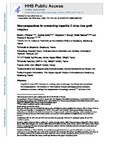New perspectives for preventing hepatitis C virus liver graft infection
| dc.contributor.author | Felmlee, Daniel | |
| dc.contributor.author | Coilly, A | |
| dc.contributor.author | Chung, RT | |
| dc.contributor.author | Samuel, D | |
| dc.contributor.author | Baumert, TF | |
| dc.date.accessioned | 2017-12-04T15:46:06Z | |
| dc.date.available | 2017-12-04T15:46:06Z | |
| dc.date.issued | 2016-06 | |
| dc.identifier.issn | 1473-3099 | |
| dc.identifier.issn | 1474-4457 | |
| dc.identifier.uri | http://hdl.handle.net/10026.1/10362 | |
| dc.description | publisher: Elsevier articletitle: New perspectives for preventing hepatitis C virus liver graft infection journaltitle: The Lancet Infectious Diseases articlelink: http://dx.doi.org/10.1016/S1473-3099(16)00120-1 content_type: article copyright: © 2016 Elsevier Ltd. All rights reserved. | |
| dc.description.abstract |
Hepatitis C virus (HCV) infection is a leading cause of end-stage liver disease that necessitates liver transplantation. The incidence of virus-induced cirrhosis and hepatocellular carcinoma continues to increase, making liver transplantation increasingly common. Infection of the engrafted liver is universal and accelerates progression to advanced liver disease, with 20-30% of patients having cirrhosis within 5 years of transplantation. Treatments of chronic HCV infection have improved dramatically, albeit with remaining challenges of failure and access, and therapeutic options to prevent graft infection during liver transplantation are emerging. Developments in directed use of new direct-acting antiviral agents (DAAs) to eliminate circulating HCV before or after transplantation in the past 5 years provide renewed hope for prevention and treatment of liver graft infection. Identification of the ideal regimen and use of DAAs reveals new ways to treat this specific population of patients. Complementing DAAs, viral entry inhibitors have been shown to prevent liver graft infection in animal models and delay graft infection in clinical trials, which shows their potential for use concomitant to transplantation. We review the challenges and pathology associated with HCV liver graft infection, highlight current and future strategies of DAA treatment timing, and discuss the potential role of entry inhibitors that might be used synergistically with DAAs to prevent or treat graft infection. | |
| dc.format.extent | 735-745 | |
| dc.format.medium | ||
| dc.language | en | |
| dc.language.iso | en | |
| dc.publisher | Elsevier BV | |
| dc.subject | Antiviral Agents | |
| dc.subject | Disease Progression | |
| dc.subject | Hepacivirus | |
| dc.subject | Hepatitis C | |
| dc.subject | Hepatitis C, Chronic | |
| dc.subject | Humans | |
| dc.subject | Incidence | |
| dc.subject | Liver Cirrhosis | |
| dc.subject | Liver Transplantation | |
| dc.subject | Virus Activation | |
| dc.title | New perspectives for preventing hepatitis C virus liver graft infection | |
| dc.type | journal-article | |
| dc.type | Journal Article | |
| dc.type | Review | |
| dc.type | Research Support, N.I.H., Extramural | |
| dc.type | Research Support, Non-U.S. Gov't | |
| plymouth.author-url | https://www.webofscience.com/api/gateway?GWVersion=2&SrcApp=PARTNER_APP&SrcAuth=LinksAMR&KeyUT=WOS:000376476500052&DestLinkType=FullRecord&DestApp=ALL_WOS&UsrCustomerID=11bb513d99f797142bcfeffcc58ea008 | |
| plymouth.issue | 6 | |
| plymouth.volume | 16 | |
| plymouth.publication-status | Published | |
| plymouth.journal | The Lancet Infectious Diseases | |
| dc.identifier.doi | 10.1016/S1473-3099(16)00120-1 | |
| plymouth.organisational-group | /Plymouth | |
| plymouth.organisational-group | /Plymouth/Faculty of Health | |
| plymouth.organisational-group | /Plymouth/Faculty of Health/Peninsula Medical School | |
| plymouth.organisational-group | /Plymouth/REF 2021 Researchers by UoA | |
| plymouth.organisational-group | /Plymouth/REF 2021 Researchers by UoA/UoA01 Clinical Medicine | |
| plymouth.organisational-group | /Plymouth/Users by role | |
| plymouth.organisational-group | /Plymouth/Users by role/Academics | |
| dc.publisher.place | United States | |
| dcterms.dateAccepted | 2016-02-15 | |
| dc.identifier.eissn | 1474-4457 | |
| dc.rights.embargoperiod | Not known | |
| rioxxterms.versionofrecord | 10.1016/S1473-3099(16)00120-1 | |
| rioxxterms.licenseref.uri | http://www.rioxx.net/licenses/all-rights-reserved | |
| rioxxterms.licenseref.startdate | 2016-06 | |
| rioxxterms.type | Journal Article/Review |


